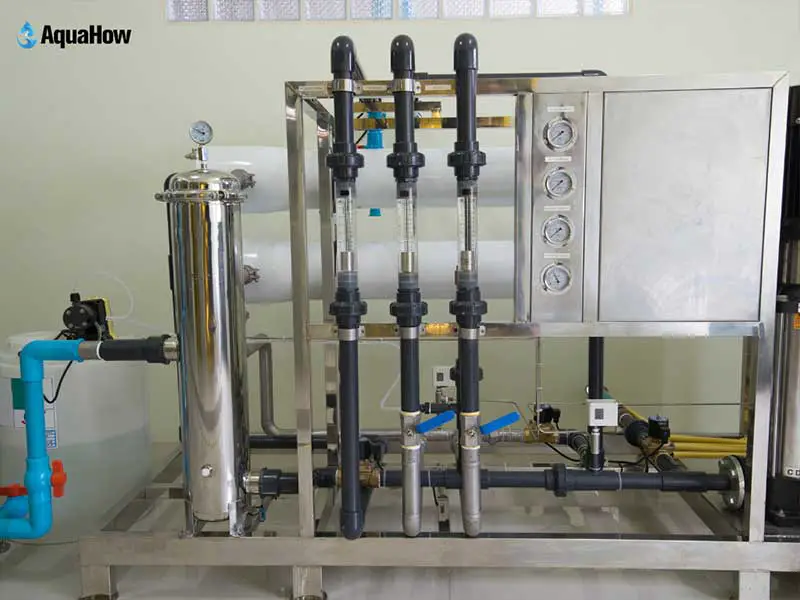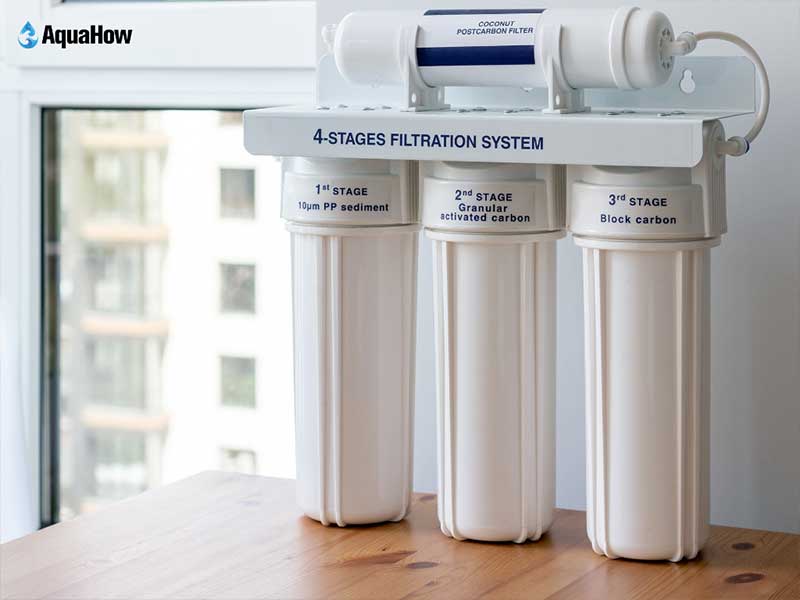I noticed that over time the filter turned completely black. In my experience,
I found that the reason for this is directly related to the filter material – in my case, the carbon used in the filter process.
I discovered that the carbon particles are microscopic and sometimes travel through the water during the filtration process and cause the filter to discolor.
Read more information below and solve your question too

These granular particles get stuck in the cartridge, making it look black. The cycle repeats again and again, which results in the black cartridge filter.
Mostly the water treatment system also uses the carbon-based filtration process. So there will be lots of carbon particles running through your water pipeline.
Additionally, the problem arises when you have installed new carbon filtration. You may have to flush plenty of water at the beginning to remove the carbon particles.
After a few days of use, the carbon settles down to the bottom of the filter, and the issue will be solved.

The powder particles of the carbons move with the water in the water tank. It eventually reaches the cartridge and gets stuck in a small area, making it look black. The water with carbon particles will taste bad, so you must take care of the filter’s initial wash to avoid particles entering your main water pipeline.
Table of Contents
How often should you wash or change the filter?

During the wash or changing the water filter, remove the carbon tank. The carbon tank will be filled with particles and germs. Run plenty of water through the tank. The powdered carbon moves to the top of the tank. Use a hose to wash away the carbon particles forcefully from the tank. It pushes the carbon particles to the top keeping the granular component at the bottom. Eventually, all the dust particles will be removed, and you will have a clear filter.
Iron water filter

All types of Iron water filter contains oxides. There are different types of Iron oxides found in the filter. Some appear red or black. When iron comes into contact with the air or temperature change, the iron turns into oxide form that leads to a chemical reaction in the metal.
Also, the manganese found in the iron sometimes turns to black or brown. You should contact the product manufacturer’s customer care team to know more about the material used in the filtration process. They will guide you in cleaning or replacing the filter.
Causes of black particles in water :
1) Mineral Traces

The iron and manganese in the running water cause the water to turn black. In the village, generally, the water is supply through the river or well.
The river bodies contain a high level of manganese that appears black or dark blue. During the filtration process, the black sediments get trapped, leading to the filter’s black layer.
If you are not conducting regular maintenance, the drinking water will turn dark black. The water’s odor will change, which is a sign of the high amount of iron and manganese in the water.
You will experience stains in the plumbing, fixtures or while doing laundry.
The manganese in the water is harmful to your body. It leads to health problems. In the case of the high amount entered to your body, the person may fall sick frequently. In the worst case, you will have organ failure and fatal consequences to your body.
Toddlers under 15 are prone to terrible manganese effects. It may decrease the learning abilities of the child.
2) Water Pipe Corrosion
The water pipes are made of iron material. Over the period, the iron particles rust and create red corrosion around the surface.
When water passes through the corrosion area, it takes the small iron particles to move them to your filters. The filtration process may or may not detect these tiny particles.
The trapped iron particles may look brown or black, depending on the condition of the pipes.

You should check the pipe around your house. Replace the line which is in bad condition. This may solve your black filter problem. You should run maintenance in your house every few years to avoid damage to the pipe.
Call a plumber and let them check all the pipelines moving around your home. A Rusty plumbing system could damage your house or break suddenly into spring.
3) Black Sand in Water
This would be easily detectable if you have a large size tank in your home. The house water filter collected all the particles and moved it to the bottom of the tank. While cleaning the water filter, check for the sign of the black sand.
The problem generally occurs when the water comes directly from the river or well. The black sand moves with the water and enters the pipe, which then reaches the filter attach to the main water line. The filter collects these pieces of silt or sand, which makes your filter turn black.

These small particles would damage your home appliances such as washing machines and dishwashers.
The solution is to store water in a water tank before passing the water to your wall filter. The sand particles will stay at the bottom, and clean water will be pass-through from the top to the filter, which will not have the sand particles.
4) Granular Activated Carbon

Granular activated carbon filtration is most common in the house filter. It is used in the cartridges as a filtration agent. Carbon contains the natural ability to kill harmful germs. Using the carbon-based filtration process makes the water clean and drinkable.
Over the period, the granular carbon particles move in the filter with the water flow, where they get trapped in the cartridge.
Granular activated carbon is black, which leads the cartridges to look black after a few filtrations of the water filter. Regular cleaning is needed to wash the stuck carbon particles from the cartridge.
Conclusion:
The whole house water filter turns black when there are substances that enter the filter. Your attention is required to clean the cartridge regularly else it substance will enter your drinking water.

